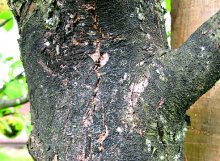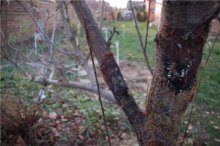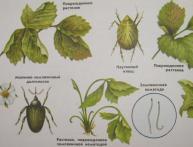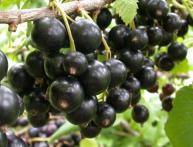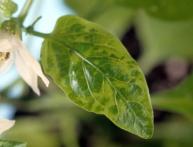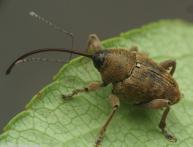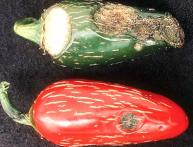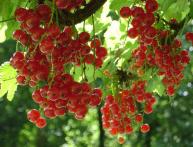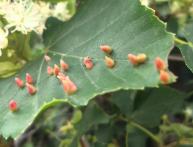Black apple cancer: why is it dangerous and how to cure it?
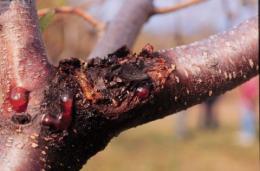
How you sometimes want to bite off a piece of a delicious apple, bake a juicy fruit in the oven with honey, or bake an airy pie. When buying apples at the market or in a store, we do not even suspect how much work gardeners have invested in caring for the fruit-bearing tree.
Content:
- What diseases are dangerous for apple trees?
- How to save an apple tree from black cancer
- The causative agent of black cancer on trees
- Types of tree cancer
What diseases are dangerous for apple trees?
An apple tree, especially in an old orchard, is susceptible to many diseases, some of which can destroy the tree forever:
- Powdery mildew. It is dangerous because it affects vital areas of the apple tree. A dirty white coating, similar to flour, appears on shoots, leaves, bark and even buds. The leaves turn yellow and dry out quickly, the shoots stop growing, and the tree gradually fades away. When winter arrives, the disease slows down, remaining to overwinter in the affected areas of the apple tree. But with the arrival of spring, the activity of the mycelium is restored.
- Scab. A fungus that attacks apple leaves. Over time, brown plaque can spread to flowers, stalks, and young seedlings. In case of illness, leaves quickly dry out and fall off. The disease is not fatal to the plant, however, scab extremely spoils the quality and appearance of the fruit.
- Cytosporosis. Apple tree bark diseases. The fungus in the form of dark ulcers affects large areas of the plant, going deeper. With improper care and watering, cytosporosis can kill the plant.
- Fruit rot.Rotten brown spots appear on apple fruits; the disease quickly spreads to neighboring apples, making the fruits completely inedible.
- Bacterial burn. It affects young seedlings, is a quarantine disease, manifests itself in the form of blackening and changes in the shape of leaves on the tree. If fire blight is left untreated, the disease will spread to all plants in the garden.
- Black apple tree cancer. The disease has other names - fireweed, Antonov fire. It affects the entire tree, but infection of the trunks is considered the most dangerous. In this case, the tree may die forever. The fungus penetrates into the heart of the tree through wounds caused by freezing of the plant or sunburn. The disease settles in the bark and rotten apples, where it overwinters, waiting for a good opportunity to resume its destructive properties.
Red-brown spots appear on the bark of black cancer, which become darker as the disease progresses. The skin of the bark swells, becomes blistered, sags and falls off altogether. In foci of black cancer, the bark becomes rough and the corresponding color is black.
The fruits of a diseased tree are covered with depressed spots. Afterwards, the apple rots and becomes completely black. Right on the branch, the fruit becomes mummified and remains in this state on the tree.
How to save an apple tree from black cancer
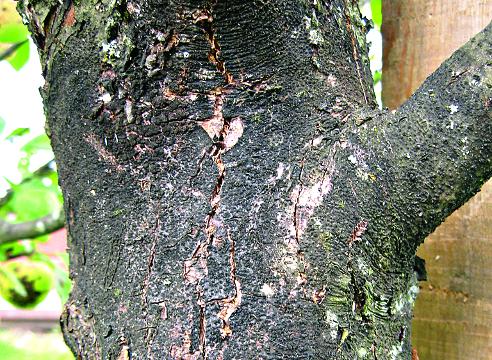
Young trees They don't get black cancer. More often this mushroom is found in gardens over 20 years old. To avoid the appearance of such a disease, young trees should be carefully looked after and watered thoroughly. If the disease nevertheless leaked into your garden and infected the apple tree, you should take some measures:
- Get rid of diseased branches
- Clean black cancer wounds
- Seal up the hollows
- Destroy rotten fruits
- Check the condition of the tree and cuts every 15-20 days
- Lime the trunk and branches in spring and autumn
Correct cutting must be done with a sharp, sharpened tool. Sections are made taking into account the capture of 1 - 2 cm of the living area. Thus, the likelihood of relapse disappears. After cutting, the section is treated with 1% -3% copper sulfate for disinfection. Then cover with putty.
Even if the tree has recovered, you should not graft cuttings from it. The disease may appear over time. Apple trees are most susceptible to disease in the spring, when it is warm and humid outside. There are known varieties of apples that are not susceptible to black cancer. These include Papirovka, Cinnamon Striped, Saffron Pepin, etc.
The causative agent of black cancer on trees
The causative agent of the disease black apple cancer is Sphaeropsis malorum Peck. This mushroom belongs to the class Deuteromycetes. Dark brown, often black, pycnidia reach a diameter of 1.5 – 5.5 cm. Single-celled spores of the fungus are colorless. After ripening they acquire a brown or brown color. Sometimes they also consist of a septum 24-30x10-12 microns.
Reproduces vegetatively using pycnospores. The source of infection is a spore living in damaged bark and branches. By attacking weakened trees, black cancer can destroy an apple tree. Temporary detection of the disease and proper treatment will lead to healing. After the rehabilitation period, the tree will be completely cured.
Black cancer affects not only the apple tree. Less often, pear and other stone fruit trees fall under its negative influence. The disease manifests itself identically to the apple tree, and is treated similarly.
Types of tree cancer
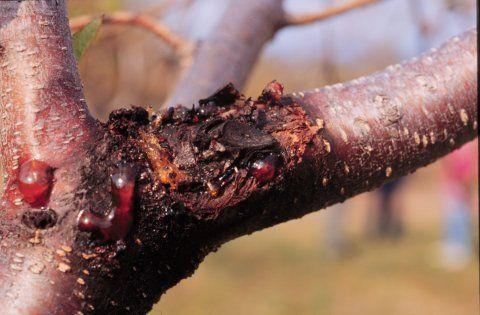
In addition to black cancer, fruit trees suffer from common and root cancer.
Common cancer affects the tree bark, skeletal branches and secondary branches. Very rarely, the disease affects the fruits of the plant. When a tree is damaged by low temperatures, wounds form, which most often heal without problems. If spores of a parasitic fungus penetrate into a fresh crack, the apple tree gets cancer. And the wounds no longer heal.
The disease is spreading similar to black cancer. Yellow spots appear on the tree bark. Then, at the site of the disease, the bark begins to die and dry out. Over time, it will completely fall off, leaving behind a trail of nodules and tumors. The fungal spores are carried by the wind during the warm summer period. In winter the disease goes away.
Root cancer appears due to the efforts of a rod-shaped bacterium living in the soil. It affects a large number of fruit plants in 18 different families. Bacteria penetrate into the roots of the tree through wounds and cracks, multiplying there through rapid division. Growths and nodules form on the roots, which, when rotting, release a huge number of harmful bacteria. They are able to live in the soil for about two more years.
The root collar of a tree is the most dangerous place for root cancer to occur. In this case, the tree is doomed to death. Favorable soil for bacteria is the soil in which seedlings and saplings are grown for a long time in the same place.
Experienced gardeners know very well what tree diseases look like. They read the necessary books and manuals on tree care. It is not enough to just plant a tree, you should always be ready to protect it, because plants are living beings. Their death is unacceptable.
An experienced gardener will tell you about the cancer that affects apple trees in the video:
Interesting information about the vegetable garden

